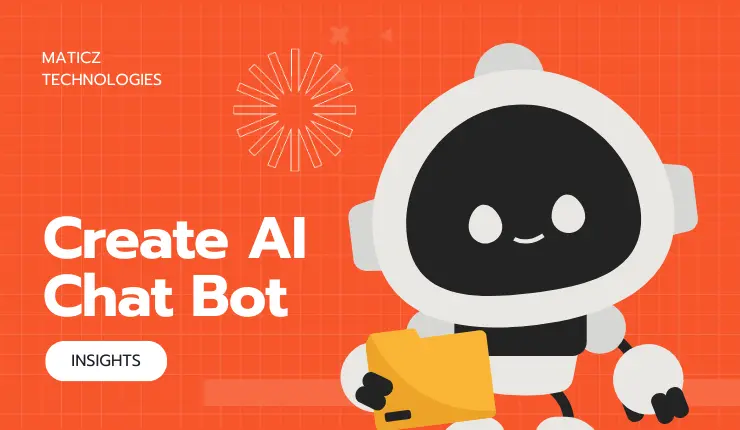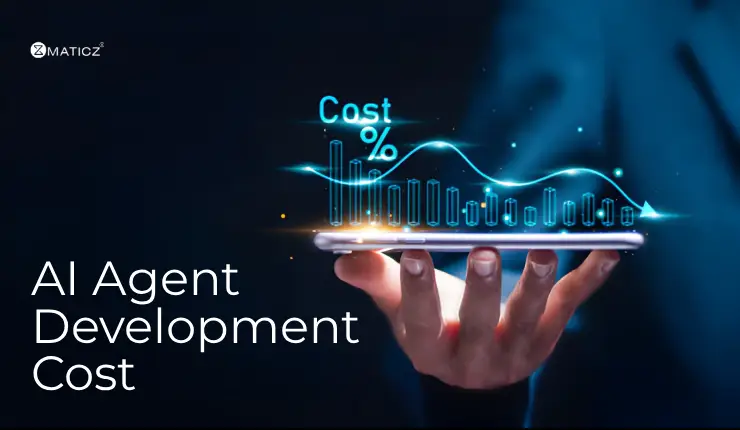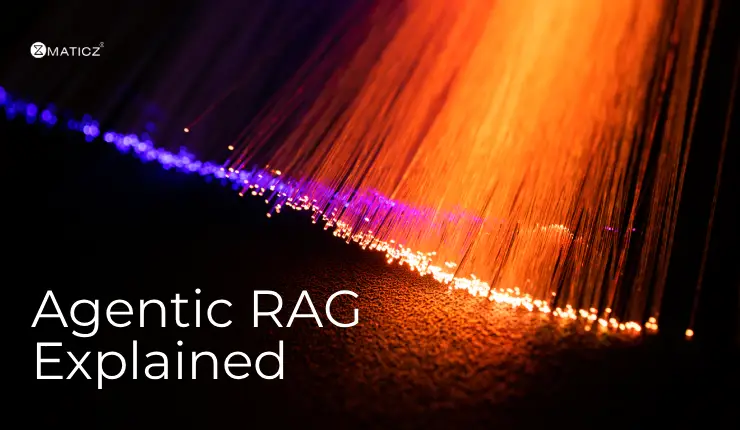Share Posts

How to Create an AI Chatbot: A Detailed Guide
46
3299
103
In today's fast-paced digital landscape, AI chatbots have become an integral tool for many modern businesses. They have carved a distinct and impactful niche from simplifying tasks to personalizing user experiences. Their significance has gone up, especially in recent years. Building an AI chatbot is a strategic move, whether you want to deliver round-the-clock support, boost sales, or improve customer services.
Creating an AI chatbot can seem like a complex task, but it doesn't have to be. This detailed guide will take you through each step, from defining your business goals to deploying a fully functional chatbot and everything in between. By following this guide, you'll learn how to build a sophisticated AI chatbot tailored to your specific needs.
Why Build an AI Chatbot?
The market for AI chatbots is growing rapidly. In 2021, the global market for chatbots was worth USD 526 million. By 2030, it is expected to grow to USD 3,619 million, which means it is growing at a rate of 23.9% each year.
There are different types of chatbots, and AI-based chatbots are expected to grow the fastest in the coming years. In 2023, rule-based chatbots, which follow predefined scripts, held a large portion of the market with a 58% share. However, AI-based chatbots are gaining popularity because they can handle more complex conversations.
Looking further ahead, in 2022, a large majority of users (88%) had at least one conversation with a chatbot. This shows that people are becoming more comfortable interacting with chatbots.
Millennials, in particular, are engaging with digital assistants regularly, with 40% using them every day. This demographic's frequent use highlights the importance of chatbots in modern digital interactions.
Chatbots are used in various areas, with the most common being sales (41%) and customer support (37%). The third most common use of chatbots is in marketing (17%), where they engage users with promotions and generate leads.
In summary, the AI chatbot market is growing quickly, and its usage is becoming more widespread across different functions like sales, customer support, and marketing. The growth of AI chatbot development is driven by the increasing comfort of users with chatbots and advancements in AI technology.
How To Make An AI Chatbot?
It is highly recommended to approach a popular AI development company like Maticz to build your own AI Chatbot. However, here is a detailed guide on how to make an AI chatbot.
Define The Business Objectives
When creating an AI chatbot, it is important to start by clearly defining the business objectives. This means understanding the specific issues the chatbot is meant to address and setting clear, measurable goals. Identify the main tasks the chatbot needs to handle, like customer service, lead generation, sales support, or internal assistance.
Think about the people who will be using the chatbot and what they need, as this will affect how the chatbot is designed and what it can do. It is also a good idea to set up ways to measure the chatbot's success, like how quickly it responds, how satisfied customers are, and how much people are engaging with it. Having clear objectives gives you a roadmap for developing the chatbot and makes sure it lines up with business goals and provides real value.
Decide On The Type Of Chatbot
When it comes to choosing the right chatbot for your business needs, it's important to consider two main types such as rule-based chatbots and AI-powered chatbots. Rule-based chatbots follow pre-defined rules and scripts, making them great for simple, repetitive tasks. They're easy to develop and manage, but they may struggle with understanding language nuances.
On the other hand, AI-powered chatbots use machine learning and natural language processing to understand and respond to user inputs, making them ideal for handling more complex interactions and learning from each conversation. Deciding between these types depends on the complexity of the tasks your chatbot needs to perform and the level of interaction required.
Select An Appropriate Tech Stack
When building a chatbot, it is more important to pick the right tech stack. The tech stack includes everything from the front-end and back-end to databases and hosting services. For the front end, you can use HTML, CSS, JavaScript, React, and Angular to make a user-friendly interface.
For the back end, you have options like Python, Node.js, Java, Ruby, Django, Flask, and Express to make sure your chatbot has all the server-side power it needs. Plus, you can store all the data your chatbot uses in databases like MySQL, PostgreSQL, MongoDB, or Cassandra. Finally, you can host your chatbot on services like AWS, Google Cloud, or Microsoft Azure to make sure it is always available and works great no matter how many people are using it.
Choose An NLP Framework
When it comes to creating a chatbot that understands and processes human language, picking the right NLP framework is very important. Some popular options include Dialogflow, IBM Watson, Microsoft Bot Framework, and Rasa. Dialogflow, created by Google, is a top choice because it has strong NLP capabilities and works well with different platforms. IBM Watson is great for its advanced NLP and Artificial Intelligence features with lots of customization options.
If you're into Microsoft's tools, the Microsoft Bot Framework is a solid choice as it integrates seamlessly with their suite of services. And if you are all about flexibility and control, Rasa, an open-source NLP framework, might be just what you need. Ultimately, the best framework for you depends on your specific needs, like how easy it is to integrate, how much customization you want, and your budget.
Prepare The Dataset
When you are getting your AI chatbot ready, it is more important to start by gathering data from different sources like customer service chats, emails, and other records of interactions. This data forms the basis for teaching your chatbot to understand and respond to users accurately.
Make sure to clean up the data by getting rid of any irrelevant info and making the format consistent. Then, label different parts of the dataset with tags like intents and entities to help the chatbot learn and understand user queries. A well-prepared dataset will make the chatbot's learning process smoother and lead to better interactions.
Design The Chatbot Conversation
When designing a chatbot conversation, it is all about creating a friendly and engaging dialogue flow that meets the user's needs. First, think about the different paths the conversation could take based on what the user says, kind of like creating a conversation roadmap. Then, you'll want to define the user's intents and the key information needed to accomplish those entities.
The main goal is to make the user experience as natural and easy as possible so that the conversation feels human-like and helpful. Effective conversation design adds value to the chatbot and enhances user satisfaction.
Build A Knowledgebase And Train The Chatbot
Building a knowledgebase and training the chatbot is essential for its functionality and performance. The knowledgebase should include all the frequently asked questions, product details, and other important information that the chatbot needs to give accurate responses.
This will help improve its ability to understand and respond to user inputs. And remember, keep updating the training data based on user interactions to make sure the chatbot stays accurate and relevant. Regular training is key to keeping the chatbot effective and up-to-date, providing users with reliable and useful information.
Tune Your Chatbot
When it comes to making your chatbot the best it can be, it's all about constantly improving and updating it. Take user feedback into account and keep an eye on how people are interacting with it. You can even try out different versions of the chatbot to see which one works best.
Monitor how accurate the responses are, how satisfied users are, and how many tasks the chatbot can help with. By fine-tuning your chatbot, you will be able to make it work even better, give users a great experience, and meet your business goals more effectively.
Integrate The Chatbot With Existing Systems
Integrating the chatbot with your existing systems will help it work smoothly within your business environment. Look for integration points, such as CRM systems, to effectively manage customer interactions and history.
You can also expand the chatbot’s reach by connecting it with popular social media platforms like Facebook Messenger and WhatsApp, so users can chat with the bot through their favorite channels. Make sure to embed the chatbot on your website and mobile apps to create a smooth user experience through instant help.
Test Your Chatbot
It is really important to test your chatbot to make sure it works well and meets the needs of your users. Start by doing alpha testing within your team to find and fix any big problems. Then, move on to beta testing with a small group of real users to get feedback and see how you can make it better.
Finally, do user acceptance testing (UAT) to make sure the chatbot does everything it needs to do for your business and users. Testing thoroughly helps you find and fix problems early on, so your users have a great experience when it is launched and you reduce the risk of problems later.
Deploy Your Chatbot
When it's time to deploy your chatbot, the final step involves making it available to users and monitoring how well it's doing. It is important to choose a reliable hosting service to make sure your chatbot is always accessible and can handle different levels of activity.
You should also use analytics tools to keep track of how your chatbot is doing, paying attention to things like how much users are interacting with it, and how accurate its responses are. Make sure to update your chatbot regularly based on what users tell you and any new needs that come up, so it stays useful and up-to-date.
How Much Does It Cost To Build Your Own AI Chatbot?
With chatbots being an integral part of almost all businesses, many have started to invest in open AI chatbots. The cost to build a simple chatbot may cost between $9000 and $16000. But if you go for a complex one with high computation and machine learning, it can cost up to $25,000. Keep in mind that this range is not fixed and it can go up to $50,000 or even more for complex chatbot features and extensive customization.
Chatbots are built with multiple functions and capabilities such as rule-based, keyword recognition-based, menu-based, contextual, and more to fit your business purposes. The complexity and scale of the project add to the cost. The more complicated the features are the more development time and developers require, which ultimately results in a high budget. Other influencing factors of chatbot development cost are programming languages, tools, development frameworks, hosting services, and more. However, if you do not have any idea about which AI chatbots are quite popular in the market, then check out the best AI chatbots available in 2024.
Benefits of Building AI Chatbots for Your Business
Implementing AI chatbots can significantly enhance various aspects of your business operations. Here are some key benefits that highlight why investing in AI chatbot technology is a smart move for any forward-thinking organization.
Reduced Operational Costs
AI chatbots can handle all sorts of tasks that usually need a human touch. Things like answering common questions, handling simple transactions, and guiding users through processes. By taking care of these repetitive tasks, you can cut down on the need for a big customer service team, which means lower costs.
Increased Customer Service Quality
AI chatbots can improve customer service by giving instant responses and reducing wait times. They can handle multiple questions at once, so no one gets left waiting. This means customers always get top-notch support, no matter what the issue is.
Boost Efficiency and Sales
Chatbots can help with sales by guiding customers to products, making recommendations, and helping with the buying process. This can lower the number of abandoned carts and increase sales. They can also suggest complementary items, which means more money in your pocket.
Drive Lead Nurturing
AI chatbots are great at keeping potential customers engaged. They can have conversations, ask the right questions, and give tailored information. By doing this, they can move potential customers through the sales process faster, which means more sales for you.
Offer Personalized Services
One of the standout benefits of AI chatbots is their ability to offer personalized services. By leveraging user data and machine learning algorithms, chatbots can provide customized recommendations, remember user preferences, and tailor responses to individual needs.
Improved Customer Engagement
AI chatbots can significantly improve customer engagement by offering interactive and engaging conversations. Chatbots can also engage users through social media platforms and mobile apps, providing a seamless and integrated customer experience.
How Can Maticz Help You in AI Chatbot Development?
Every business is unique, and so are its requirements. Developing a custom AI chatbot requires expertise in various fields. Maticz is a leading AI chatbot development company that can assist you in creating a sophisticated AI chatbot tailored to your business needs. We stay at the forefront of technological advancements, leveraging the latest AI and machine learning tools to build state-of-the-art chatbots. We stay at the forefront of technological advancements, leveraging the latest AI and machine learning tools to build state-of-the-art chatbots. Partner with Maticz to leverage cutting-edge technologies and transform your customer interactions with an intelligent AI chatbot.
Tap Into the Future
The latest insights, posts, and project updates - straight to your inbox.




